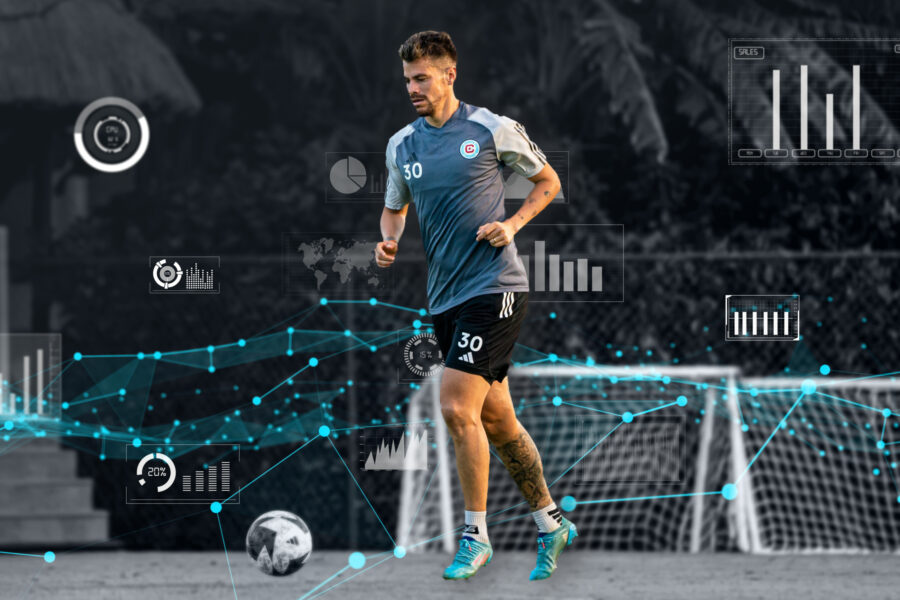Chicago Fire Revolutionize Their Player Tracking with WIMU

The Chicago Fire are integrating WIMU into their analysis process for the first time this season. As the MLS season gets into the heart of its schedule, they’re depending on its data to optimize player and team performance.
The games elite have long relied on data and analytics to gain a competitive edge. Human performance tracking is a critical component of that analysis, and for sports scientists across the world, they rely on the insights gleaned from wearables to maximize the performance of their athletes.
WIMU powered by Hudl and its industry-leading player tracking data has become an integral part of sports science departments across sport– and no sport relies on human performance tracking more than global football. With teams playing in multiple matches and competitions in any given week, it’s critical that teams monitor and track player load, to ensure that every player is getting the proper rest and recovery so they can maximize performance on match day.
We use [WIMU] every day, not only for training but also for the games.
[WIMU] gives us a little more to understand what’s going on on the pitch so we can operate differently, because each individual is different.
The Chicago Fire are integrating WIMU for the first time this season, and it has already been an integral part of their process every single day. Tracking player performance through the use of wearables is nothing new to their process. But WIMU has provided them something different. “We use [WIMU] every day,” Cho explained. “Not only for training but also for the games. In every game, we see their normal match demand, which usually we consider as their worst case scenario because in the match, you never know what’s going to happen. But at the same time, you see their maximum effort, and then some sort of unexpected physical output can happen.
“So in the training, which are in relatively controlled environment, you want to prepare for the match demand. Based on their individual match demand, we target differently for each individual. [WIMU] gives us a little more to information to help us understanding what’s going on the pitch so we can approach differently, because each individual is different.”
Data from WIMU like player load, high speed running relative speed, match velocity, acceleration, etc. is critical to optimizing training programs for the club’s players, for preventing injuries and to improve overall team performance on match day. These metrics go hand in hand with the data Cho and the members of the first team coaching staff look at when analyzing their players' outputs during matches. “If you look at [two] centre-backs,” Cho explained. “Generally same role, but you see different styles of play, different running speeds, and etc. You cannot approach the same training target for those two different players, just because they are in the same position."
Cho continued with this example, “One center back might not be reaching their near max speed during a game– because you were sitting back, you know, more focused on defending. While the other centre-back, let's say he's involved more in our attacking cornerkick, then he has to sprint back to his initial position when we lose the ball in our defensive transition. This center back is probably reaching near maximum sprinting speed for the most of the games. So, if you see those different scenarios, you have to keep in mind the specific player’s role. So, using WIMU helps us to monitor these players’ sprinting volume and intensity, how many meters with how fast speed, during the training."
You see the difference when you didn’t explain why you’re doing the training… because once the player understands [why], they’ll give you the actual effort that we want [from] them.
For Cho, it’s not just as simple as communicating a number to the coaching staff to build a plan. It’s about effectively communicating key data points with his coaches to provide valuable context. The numbers tell a part of the story. The advanced tracking of WIMU’s GPS allows the Chicago Fire to dive even deeper into specifics, so they can understand the context surrounding a particular number. “I like to use the match data as a target,” Cho said. “Using the GPS [data], you can go a little bit deeper into the analysis from the match. So you can break down, let's say a 45 minute [half], into every five minutes, every minute, or even the moving average to check what specific time each individual reached their peak.”
Furthermore, the insights gained improve their communication with the players. “It’s very important for us,” Cho said. “You see the difference, when you explain players why we do certain training versus when you don’t explain. Because once the players understand [why], they’ll give you the actual effort that we want [from] them.”
As the game has evolved, sports scientists have become an integral part of every club across global football. The importance of human performance tracking has never been more relevant than it is today. Cho recognizes its potential for impact, but also understands the trepidation some might have to open up their teams to this level of analysis. “I see some of the misunderstanding but as long as you get the data and use it correctly, I think it actually gives you a really good chance to understand what’s going on on the pitch. So it’s not only from your feelings, your eyes, but there’s all the data. You can see the clear thresholds for each individual. Then you can use it in pretty much every scenario,” said Cho.
